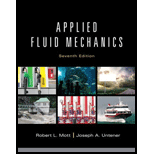
Applied Fluid Mechanics (7th Edition)
7th Edition
ISBN: 9780132558921
Author: Robert L. Mott, Joseph A. Untener
Publisher: PEARSON
expand_more
expand_more
format_list_bulleted
Textbook Question
Chapter 9, Problem 9.34PP
Figure 9.23 shows the cross section of a cooling passage for an odd-shaped device Compute the volume flow
irate of water at
Expert Solution & Answer
Want to see the full answer?
Check out a sample textbook solution
Students have asked these similar questions
4. Solve for the support reactions at A and B.
W1 600 lb/ft
W2 150 lb/ft
A
B
In cold isostatic pressing, the mold is most typically made of which one of the following:
thermosetting polymer
tool steel
sheet metal
textile
rubber
The coefficient of friction between the part and the tool in cold working tends to be:
lower
higher
no different relative to its value in hot working
Chapter 9 Solutions
Applied Fluid Mechanics (7th Edition)
Ch. 9 - Compute points on the velocity profile from the...Ch. 9 - s9.2 Compute points on the velocity profile from...Ch. 9 - Compute points on the velocity profile from the...Ch. 9 - Compute points on the velocity profile from the...Ch. 9 - A small velocity probe is to be inserted through a...Ch. 9 - If the accuracy of positioning the probe described...Ch. 9 - An alternative scheme for using the velocity probe...Ch. 9 - Prob. 9.8PPCh. 9 - For the flow of 12.9L/min of water at 75C in a...Ch. 9 - A large pipeline with a 1,200m inside diameter...
Ch. 9 - Prob. 9.11PPCh. 9 - Prob. 9.12PPCh. 9 - Prob. 9.13PPCh. 9 - Prob. 9.14PPCh. 9 - Using Eq. (9-4), compute the ratio of the average...Ch. 9 - Prob. 9.16PPCh. 9 - Repeat Problem 9.16 for the same conditions,...Ch. 9 - Prob. 9.18PPCh. 9 - A shell-and-tube heat exchanger is made of two...Ch. 9 - Figure 9.14 shows a heat exchanger in which each...Ch. 9 - Figure 9.15 shows the cross section of a...Ch. 9 - Air with a specific weight of 12.5N/m3 and a...Ch. 9 - Carbon dioxide with a specific weight of...Ch. 9 - Water at 90F flows in the space between 6 in...Ch. 9 - Refer to the shell-and-tube heat exchanger shown...Ch. 9 - Refer to Fig. 9.14, which shows two DN 150...Ch. 9 - Refer to Fig. 9.15, which shows three pipes inside...Ch. 9 - Water at 10C is flowing in the shell shown in Fig....Ch. 9 - Figure 9.19 shows the cross section of a heat...Ch. 9 - Figure 9.20 shows a liquid-to-air heat exchanger...Ch. 9 - Glycerin ( sg=1.26 ) at 40C flows in the portion...Ch. 9 - Each of the square tubes shown in Fig. 9.21...Ch. 9 - A heat sink for an electronic circuit is made by...Ch. 9 - Figure 9.23 shows the cross section of a cooling...Ch. 9 - Prob. 9.35PPCh. 9 - The blade of a gas turbine engine contains...Ch. 9 - For the system described in Problem 9.24. compute...Ch. 9 - For the shell-and-tube heat exchanger described in...Ch. 9 - For the system described in Problem 9.26 compute...Ch. 9 - For the system described in Problem 9.27 compute...Ch. 9 - For the shell-and-tube heat exchanger described in...Ch. 9 - For the heat exchanger described in Problem 9.29...Ch. 9 - For the glycerin described in Problem 9.31 compute...Ch. 9 - For the flow of water in the square tubes...Ch. 9 - If the heat sink described in Problem 9.33 is 105...Ch. 9 - Compute the energy loss for the flow of water in...Ch. 9 - In Fig. 9.26 ethylene glycol ( sg=1.10 ) at 77F...Ch. 9 - Figure 9.27 shows a duct in which methyl alcohol...Ch. 9 - Prob. 9.49PPCh. 9 - Figure 9.29 shows a system in which methyl alcohol...Ch. 9 - A simple heat exchanger is made by welding...Ch. 9 - Three surfaces of an instrument package are cooled...Ch. 9 - Figure 9.32 shows a heat exchanger with internal...
Knowledge Booster
Learn more about
Need a deep-dive on the concept behind this application? Look no further. Learn more about this topic, mechanical-engineering and related others by exploring similar questions and additional content below.Similar questions
- The force F={25i−45j+15k}F={25i−45j+15k} lblb acts at the end A of the pipe assembly shown in (Figure 1). Determine the magnitude of the component F1 which acts along the member AB. Determine the magnitude of the component F2 which acts perpendicular to the AB.arrow_forwardHi can you please help me with the attached question?arrow_forwardHi can you please help me with the attached question?arrow_forward
- Please can you help me with the attached question?arrow_forward4. The rod ABCD is made of an aluminum for which E = 70 GPa. For the loading shown, determine the deflection of (a) point B, (b) point D. 1.75 m Area = 800 mm² 100 kN B 1.25 m с Area = 500 mm² 75 kN 1.5 m D 50 kNarrow_forwardResearch and select different values for the R ratio from various engine models, then analyze how these changes affect instantaneous velocity and acceleration, presenting your findings visually using graphs.arrow_forward
arrow_back_ios
SEE MORE QUESTIONS
arrow_forward_ios
Recommended textbooks for you
 Principles of Heat Transfer (Activate Learning wi...Mechanical EngineeringISBN:9781305387102Author:Kreith, Frank; Manglik, Raj M.Publisher:Cengage Learning
Principles of Heat Transfer (Activate Learning wi...Mechanical EngineeringISBN:9781305387102Author:Kreith, Frank; Manglik, Raj M.Publisher:Cengage Learning

Principles of Heat Transfer (Activate Learning wi...
Mechanical Engineering
ISBN:9781305387102
Author:Kreith, Frank; Manglik, Raj M.
Publisher:Cengage Learning
Intro to Compressible Flows — Lesson 1; Author: Ansys Learning;https://www.youtube.com/watch?v=OgR6j8TzA5Y;License: Standard Youtube License